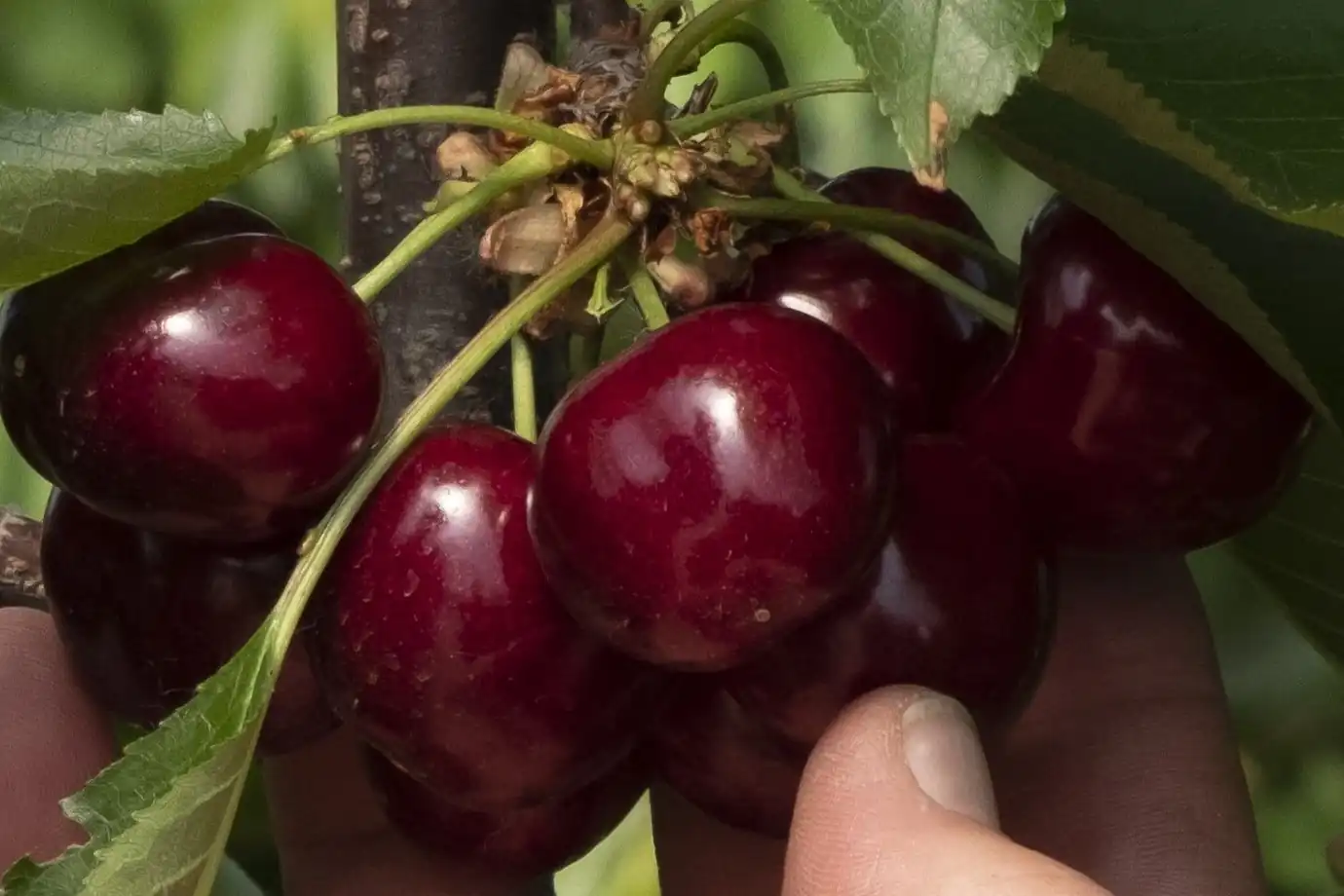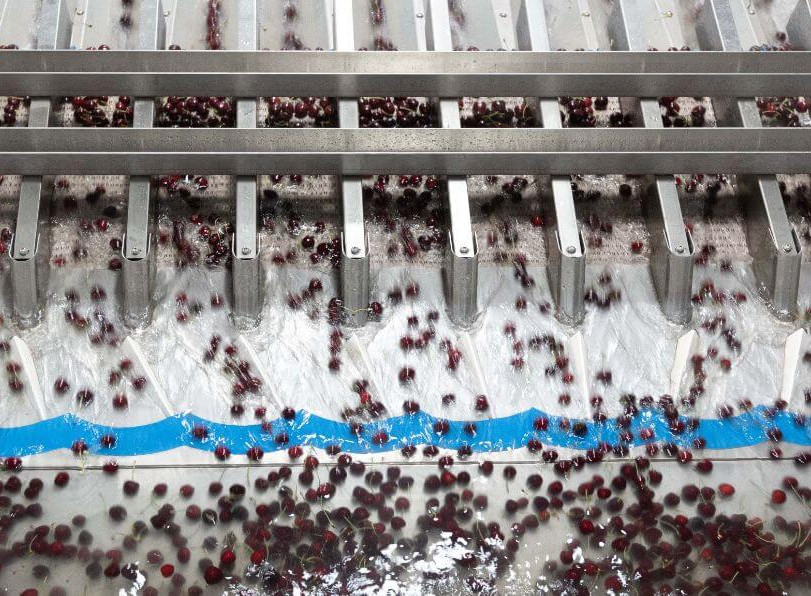Potassium (K) plays key physiological roles in plants, such as stomatal regulation, carbohydrate transport, and pigment synthesis including anthocyanins and flavonoids.
During the final stage of fruit development, this element is crucial for achieving the color, size, and firmness required for export.
K-MAD® is an innovative formulation developed by CODA, designed to meet the high potassium demand during the pre-harvest period, when root uptake may be limited.
The formulation aims to enhance photosynthetic metabolism, sugar translocation, and pigment synthesis, optimizing commercial quality and harvest uniformity.
General Objective
To evaluate the effect of the pre-harvest application of K-MAD® on quality parameters (weight, size, color, and soluble solids) of sweet cherry fruits, cv. Santina, Lapins, and Bing.

Materials and Methods
Experimental Sites
The trials were conducted on three farms in the Maule Region (Chile), in the municipalities of Hualañé and Curicó.
The evaluated varieties were Santina, Lapins, and Bing, all grafted onto Colt, CAB-6P, or Maxma 14 rootstocks, trained to central leader or V-trellis systems.
Treatments and Experimental Design
The following treatments were applied:
- K-MAD®: 40 L ha⁻¹, divided into two 20 L ha⁻¹ applications via fertigation.
- Control: no application.
Treatments were evaluated on plots of 0.5 to 3 ha depending on the site, using a simple comparative design with random fruit sampling.
Evaluated Parameters
For each treatment, 30 to 80 random fruits were collected and evaluated for:
- Fruit weight (g) using an electronic scale.
- Fruit diameter (mm) using a digital caliper.
- Soluble solids (°Brix) using a refractometer.
- Skin color, classified on a visual scale of eight levels (from “light” to “black”).
Thirty days after harvest, a leaf analysis was conducted to determine residual potassium content (Dumas and Kjeldahl methods).
Main Results
Fruit Size and Weight
Fruits treated with K-MAD® showed sizes predominantly between 26 and 32 mm (Jumbo–2J–3J), above the minimum standards for Asian export markets (≥ 26 mm), with weights mostly ranging between 10 and 14 g.
In the case of Santina, 83% of the fruits exceeded the Jumbo size.
Soluble Solids
Potassium treatments increased sugar contents to between 16 and 21 °Brix, with averages of 17.5–18 °Brix, higher than the controls.
This effect is related to improved carbohydrate translocation and better osmotic regulation, promoting sugar accumulation in the fruit.
Fruit Color
The K-MAD® treatment achieved over 70% of fruits with red-mahogany and mahogany color, compared to 40–50% in controls, advancing harvest timing and improving the visual quality required by Asian markets.
Leaf Potassium Content
Post-harvest leaf potassium content remained high:
- 2.43% in Santina (Hualañé)
- 1.77% in Lapins (Hualañé)
- 3.06% in Santina (Curicó)
These values are within or above the optimal range (1.6–3.0%), showing that K-MAD® applications improved not only fruit quality but also post-harvest nutritional status, supporting reserve replenishment.
Discussion
The results are consistent with recent scientific literature highlighting the role of potassium in anthocyanin synthesis and sugar accumulation in stone fruits (Mengel & Kirkby, 2001; Esteban et al., 2015).
The correlation between higher °Brix values and more intense color indicates that K-MAD® optimizes carbon metabolism and photosynthetic efficiency during ripening.
Moreover, maintaining high leaf potassium levels after harvest suggests effective reserve replenishment, crucial for budburst and flowering in the following season.
This is enabled by the presence of free amino acids in the formulation, which enhance root absorption and subsequent metabolic assimilation of potassium, amplifying its physiological effects without stimulating the root system with additional products.
K-MAD® provides a physiologically efficient technology that keeps potassium in available form, improves root uptake even under saline stress, and increases nutrient use efficiency as well as final fruit quality.
In soils with high salinity, expansive clays, or limited infiltration, conventional potassium fertilizers may worsen structural and osmotic problems in the soil-plant system; in these cases, K-MAD® can not only replace traditional potassium but turn nutrition into a physiological tool capable of sustaining yield and quality even in restrictive soil environments.
Under clayey and saline soil conditions, trials conducted on cherry, table grape, and avocado have shown that K-MAD®:
- increases leaf potassium levels by 15–25%
- reduces soil solution electrical conductivity by 10–20% compared with KCl or K₂SO₄
- improves fruit coloration, firmness, and soluble solids
- reduces susceptibility to osmotic stress-related disorders, such as cracking or premature softening
Conclusions
K-MAD® application significantly increases cherry color, size, weight, and soluble solids compared to untreated controls.
With K-MAD®, earlier ripening and greater harvest uniformity were achieved, providing a commercial advantage.
Leaf potassium levels remained high after harvest, indicating efficient uptake and nutrient persistence.
It is an excellent alternative potassium source under restrictive soil conditions.
Image source: SL Fruit Service
Q-Agro
Cherry Times - All rights reserved













